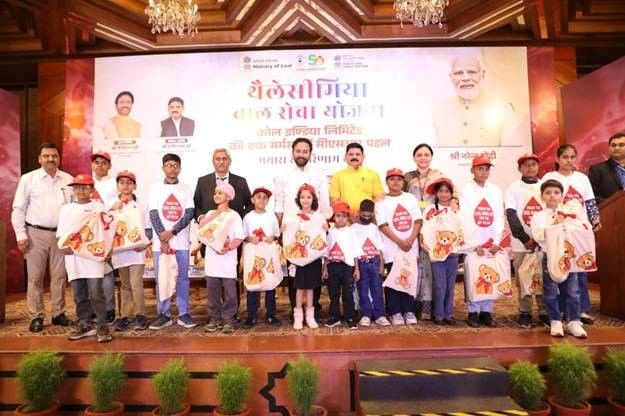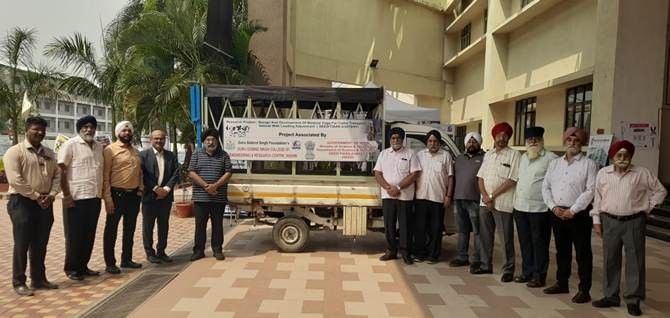UPSC Exam > UPSC Notes > PIB (Press Information Bureau) Summary > PIB Summary - 9th May, 2025
PIB Summary - 9th May, 2025 | PIB (Press Information Bureau) Summary - UPSC PDF Download
Coal India’s Thalassemia Bal Sewa Yojana

What is Thalassemia?
- Thalassemia is a genetic disorder that impacts the production of hemoglobin in the blood.
- Hemoglobin is crucial for carrying oxygen in the blood, and its deficiency leads to anemia, a condition characterized by low red blood cell counts.
- This disorder is inherited from one or both parents through a genetic mechanism known as autosomal recessive inheritance.
Types of Thalassemia
Alpha Thalassemia
- Caused by mutations in the alpha-globin genes responsible for producing part of hemoglobin.
- The severity of alpha thalassemia can vary widely, from mild forms to severe cases like Hydrops Fetalis, which is life-threatening.
Beta Thalassemia
- Resulting from mutations in the beta-globin genes.
- Subtypes of Beta Thalassemia:
- Thalassemia Minor (Carrier): Usually mild and often undiagnosed, individuals are carriers of the gene mutation.
- Thalassemia Intermedia (Moderate): Causes moderate anemia and may require occasional blood transfusions.
- Thalassemia Major (Severe): Leads to severe anemia and requires regular blood transfusions and other treatments.
Symptoms
- Fatigue and Weakness: Individuals often feel tired and weak due to the lack of sufficient healthy red blood cells to carry oxygen.
- Pale or Yellowish Skin: The skin may appear pale or have a yellowish tint due to the breakdown of red blood cells and the resulting bilirubin increase.
- Delayed Growth and Development in Children: Children with thalassemia may experience delays in growth and development due to chronic anemia.
- Enlarged Spleen (Splenomegaly): The spleen may become enlarged as it works harder to filter abnormal blood cells.
- Bone Deformities, Especially in the Face: Thalassemia can lead to bone deformities, particularly in the facial structure, due to the expansion of bone marrow space where blood cells are produced.
Key Highlights of the Thalassemia Bal Sewa Yojana (TBSY)
- CIL's Initiative: The Thalassemia Bal Sewa Yojana is a flagship Corporate Social Responsibility (CSR) initiative by Coal India Limited (CIL).
- Free Bone Marrow Transplants: TBSY provides free bone marrow transplants (BMTs) to children suffering from thalassemia and aplastic anemia, which are serious blood disorders.
- Number of Transplants: Over 700 children have benefited from this program, receiving life-saving transplants.
- Financial Assistance: The program includes financial assistance of up to ₹10 lakh (1 million rupees) per child to cover medical expenses.
- Impact on Families: Families are relieved from major medical expenses, and many children who received transplants are now leading normal lives.
Government Vision & Support
- "One State, One Hospital" Plan: Minister G. Kishan Reddy announced this plan to establish dedicated hospitals for Bone Marrow Transplants (BMT) under the Thalassemia Bal Sewa Yojana (TBSY).
- Prevention Strategies: Emphasis on early screening, genetic counseling, and raising awareness about thalassemia as crucial measures for prevention.
- Patient-Centric Approaches: Call for approaches that prioritize patients' needs and involve collaborative efforts to achieve a thalassemia-free India.
- TBSY as a Model: The Thalassemia Bal Sewa Yojana is highlighted as a model of hope, showcasing humane, inclusive, and sustainable development practices.
Institutional Collaboration & Expansion
- Initial and Current Hospitals: The program started with 4 hospitals and has now expanded to include 17 premier hospitals offering Bone Marrow Transplant services.
- Collaborating Organizations: TBSY collaborates with Thalassemics India, the Ministry of Health, and hospitals run by Coal India Limited (CIL) to provide comprehensive care.
- Online Portal: An online portal has been launched to facilitate real-time applications and monitoring of the program, enhancing efficiency and transparency.
- Rural Outreach: Outreach efforts have been extended to rural areas to raise awareness about thalassemia and the available services. This includes distributing pamphlets, posters, and producing short films to educate the public.
Other National-Level Government Initiatives
National Policy for Rare Diseases (NPRD) 2021
- The NPRD addresses rare diseases, including thalassemia, by classifying them into three groups based on treatment type and cost.
- It provides financial support of up to ₹20 lakh for one-time curative treatments such as bone marrow transplants.
- The policy also promotes crowd-funding and corporate social responsibility (CSR) initiatives to support patients.
National Program for Control of Blood Disorders (NPCBD)
- The NPCBD focuses on the prevention, awareness, screening, and safe transfusion of blood disorders, including thalassemia.
- It supports the development of infrastructure and training for thalassemia care, ensuring better management and treatment of patients.
Global Thalassemia Facts
- Carrier Rate: Approximately 5.2% globally, with an estimated 300,000 to 400,000 affected births each year.
- Birth Incidence: 4.4 cases of thalassemia per 10,000 live births.
- Decline in Burden (1990–2021):
- Prevalence decreased by 19%.
- Deaths reduced from 12,000 to 5,897.
- Mortality rate decreased from 0.69 to 0.29 per 100,000 population.
Thalassemia in India
- Carrier Prevalence: Estimated at 3% to 4%, translating to around 30 to 40 million people in India being carriers of the thalassemia gene.
- Affected Births: Annually, 10,000 to 15,000 children are born with β-thalassemia major, a severe form of the disease.
- High-Risk Areas: Certain regions in India, such as Gujarat, Maharashtra, Punjab, and various tribal areas, have a higher prevalence of thalassemia, with carrier rates reaching up to 17%.
Conclusion
- The Thalassemia Bal Sewa Yojana (TBSY) exemplifies a successful model where corporate social responsibility aligns with national health objectives.
- It showcases the potential of public-private partnerships in tackling significant healthcare challenges, particularly in providing critical treatments like bone marrow transplants to children in need.
- TBSY reinforces the idea of compassionate governance and inclusive development, demonstrating how collaborative efforts can lead to positive health outcomes and improve the quality of life for affected families.
New smart cage can smoothen cattle transport in India

Key Issues in Traditional Cattle Transport
- Open Trucks: Many transporters use open trucks that are not properly fitted for carrying cattle. These trucks lack basic safety measures, putting the animals at risk.
- Stress and Injuries: The current methods of transporting cattle cause high levels of stress and injuries to the animals during transit.
- Loading and Unloading: The mechanisms for loading and unloading cattle are inefficient, making the process difficult and unsafe for the animals.
- Animal Welfare Violations: Traditional transport methods violate animal welfare norms, which are in place to protect the well-being of the animals.
- Operational Challenges: These issues create operational challenges for farmers and transporters, making the process of transporting cattle more difficult.
- Legal Non-Compliance: Many transporters do not comply with Rule 125E of the Motor Vehicle Rules, 1989, which sets specific requirements for vehicles transporting livestock.
Innovative Smart Cage Solution
- Developed by: Prof. Sandip S. Patil from Guru Gobind Singh College of Engineering & Research Centre, Nashik.
- Funded by: DST-SEED (Science for Equity, Empowerment, and Development).
- Design Features:
- Telescopic Sliding: Allows the cage size to be adjusted to fit various vehicles.
- Foldable Ramp-Cum-Door: Facilitates smooth and safe loading/unloading.
- Roller-Assisted Movement: Aids in easy alignment of the cage.
- Cross-Link Mesh: Provides ventilation and enhances durability.
- Reinforced Metal Frame: Ensures safety and strength of the cage.
- Optimized Airflow: Computational Fluid Dynamics (CFD) is used to improve airflow within the cage.
Advantages & Impacts
- Reduced Injuries and Stress: The smart cage significantly lowers the risk of injuries and stress levels in cattle during transport.
- Legal Compliance: The solution adheres to animal welfare laws, reducing the likelihood of legal issues for transporters.
- Adaptability: The cage can be adapted to double-storied configurations, making it suitable for larger loads.
- Cost-Effectiveness: The solution is affordable and scalable, making it ideal for small-scale rural farmers.
- Promotion of Humane Practices: The smart cage encourages humane practices in livestock transport, benefiting animals and farmers alike.
- Versatility: It is useful for various applications including dairies, Gaushalas, veterinary services, and short-distance livestock transport.
Implementation & Recognition
- Successful Testing: The smart cage solution has been successfully tested in Ambad Village, Nashik.
- Patent Recognition: The innovation has been recognized with two Indian patents in 2024 for its modular and double-storey variants.
- Scale-Up Plans: There are plans to scale up the implementation of the smart cage solution through CSR funding and community deployment.
Livestock Statistics in India (21st Livestock Census 2024)
- Total Livestock Population: 536.76 million, which is a 4.6% increase from the previous census in 2012.
- Cattle Population: 193.46 million, including various subcategories of cattle.
- Buffalo Population: 109.85 million, showing a 1.1% increase from the last census.
- Goat Population: 148.88 million.
- Sheep Population: 74.26 million.
- Poultry Population: 851.81 million, reflecting a significant increase of 16.8% from the previous census.
Additional Dimensions
- Technological Innovations: Using advanced, modular cages with features like foldable ramps and better ventilation can improve animal safety during transport.
- Regulatory Enforcement: Strengthening the enforcement of existing laws to ensure humane and legal transportation practices is crucial.
- Training and Awareness: Educating farmers and transporters about best practices in animal handling and transport can reduce stress and injuries significantly.
- Infrastructure Development: Investing in dedicated livestock transport vehicles and facilities can facilitate safe and efficient movement of animals.
- Research and Development: Encouraging studies on animal behavior during transport can help in designing welfare-friendly transport systems.
The document PIB Summary - 9th May, 2025 | PIB (Press Information Bureau) Summary - UPSC is a part of the UPSC Course PIB (Press Information Bureau) Summary.
All you need of UPSC at this link: UPSC
FAQs on PIB Summary - 9th May, 2025 - PIB (Press Information Bureau) Summary - UPSC
| 1. What is the Thalassemia Bal Sewa Yojana by Coal India? |  |
Ans. The Thalassemia Bal Sewa Yojana is an initiative launched by Coal India to support children suffering from thalassemia, a genetic blood disorder. The program aims to provide financial assistance for their treatment, ensuring that affected children receive the necessary medical care and support to manage their condition effectively.
| 2. How does the new smart cage improve cattle transport in India? |  |
Ans. The new smart cage is designed to enhance the efficiency and safety of cattle transport in India. It incorporates innovative technology that allows for better monitoring and management of cattle during transit. The smart cage ensures that animals are securely held, reducing stress and injury, while also providing real-time data to handlers about the animals' health and wellbeing.
| 3. What are the benefits of the Thalassemia Bal Sewa Yojana for families? |  |
Ans. Families benefiting from the Thalassemia Bal Sewa Yojana receive financial assistance that helps cover the costs of medical treatments, including regular blood transfusions and necessary medications. This support alleviates the financial burden on families, allowing them to focus on the health and well-being of their children without the added stress of medical expenses.
| 4. Who is eligible to apply for the Thalassemia Bal Sewa Yojana? |  |
Ans. Eligibility for the Thalassemia Bal Sewa Yojana typically includes children diagnosed with thalassemia who come from economically disadvantaged backgrounds. Families must submit necessary documentation, including medical records and proof of income, to qualify for the financial assistance provided by the program.
| 5. What impact does the smart cage technology have on the livestock industry in India? |  |
Ans. The introduction of smart cage technology is expected to significantly improve the livestock industry in India by ensuring better animal welfare during transport, reducing losses due to injury or stress, and enhancing overall efficiency in cattle logistics. This innovation can lead to higher productivity and better market opportunities for farmers and livestock traders.
Related Searches
















